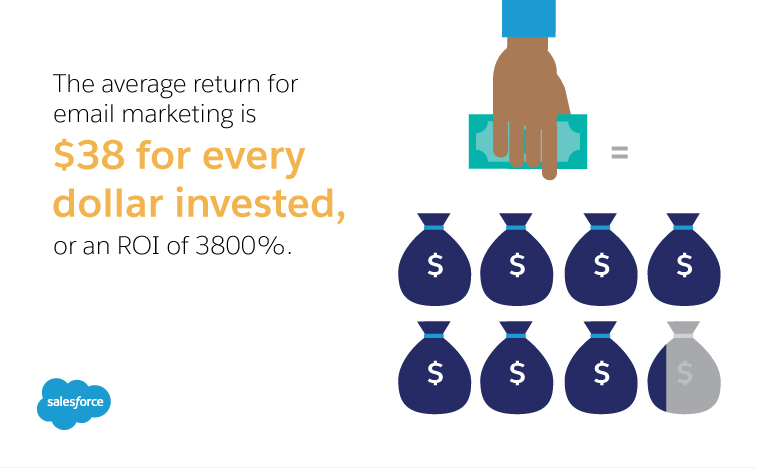If you’ve recently launched a startup company, one of the first things you should do is build an active email subscriber list. Email marketing platforms will make your life much easier. Build your opt-in landing page Now that you’ve selected a platform for sending emails, it’s time for you to set up a way for your website visitors to subscribe to this list. Give people a reason to subscribe Your company might be great, but not everyone knows that. You can have a pop-up or promotion on your homepage offering a discount off a purchase when a customer signs up to receive emails. Send relevant and timely content Now that you’ve got subscribers, you don’t want to lose them. Make sure you send promotional content to your subscribers. Now, you just need to use your email strategy to increase conversions and drive sales through offering great content. Segment your subscribers so it’s easier to send them timely and highly relevant content. What strategies is your brand using to add more subscribers to your first email marketing list?
Contrary to popular belief, email marketing is not dead.
Sure, there are newer content marketing strategies out there today that may seem more appealing. But if you want your business to thrive, you’ve got to have a core foundation for your strategy.
Stick to the basics. If you’ve recently launched a startup company, one of the first things you should do is build an active email subscriber list.
It’s one of the best ways to get people excited about and engaged with your brand. You’ll use this list to stay in contact with your customers on a regular basis.
Ultimately, your email subscriber list will help you increase engagement, generate leads, and drive conversions.
What’s even more appealing about email marketing is how profitable it can be. In fact, the average return on investment for email marketing campaigns is a whopping 3,800%:

If you have been in business for a while but still don’t have an active list of subscribers, this guide is relevant to you as well. It’s not too late for you to get started with your first list.
You may be a little bit behind right now, but if you want to catch up to your competitors, start focusing on your email marketing strategy as soon as possible.
That said, starting from zero can be daunting. It feels as if you’ve got a long climb ahead of you.
Don’t worry, we’ve all been there.
Fortunately, if you follow the tips I’ve outlined in this guide, you’ll have a much easier time building your first email list from scratch.
Pick your platform
Before you proceed with anything else, you need to choose email software you’d like to use.
This will depend on many factors based on the wants and needs of your company, but you’ll have plenty of options to choose from. Constant Contact is a great starting point for beginners:

For the most part, they all will have similar features and benefits. It all depends on your preferences for the interface, pricing, and other factors.
Compare at least a few of these choices before deciding. One thing for sure: you’ll need software to help you with this task.
Email marketing platforms will make your life much easier. That’s because what you’re trying to accomplish here is much different from sending a mass email to your friends and family.
Sending promotional content to your subscribers directly from your personal email account isn’t a viable option if you want to take things seriously.
Plus, you’d spend way more time than you needed to if you did this manually. We both know how much you value your time, so take advantage of any available time-saving marketing tools.
Build your opt-in landing page
Now that you’ve selected a platform for sending emails, it’s time for you to set up a way for your website visitors to subscribe to this list.
You need to build a strong landing page specifically designed for turning web traffic into subscribers. In theory, this is simple, right?
But you’ll need to do much more than creating a landing page that says “Sign up for emails.” That alone won’t be enough to add subscribers.
There is a science behind landing pages that drive conversions. For example, you need to take into consideration the placement of your opt-in button:

As you can see from this data, placing the button in the footer results in a drastically higher conversion rate than placing it in other locations on the page.
I can’t emphasize enough how important it is for you to take your time when designing the layout of your opt-in landing page. Make sure it’s simple and clear, and think about other aspects such as the color scheme.
That’s because you can’t rely only on users visiting your website to navigate to this page. As I’ll discuss shortly, people will land on this page from a variety of sources and marketing channels. And that’s why you’ll need to take other factors into consideration as well.
Drive traffic to your landing page
You’ve got your email platform set up, and your landing page has been built. Now, you need to convert your website visitors into email subscribers.
The best way to do this is to get as much traffic as possible to your landing page.
You can start by increasing your SEO efforts, but that alone won’t be enough to build a huge subscriber list. You’ll need to feature this landing page on as many of your marketing channels as possible.
Share the link on your social media channels. Blog about it.
Put a CTA on the sidebar of each page on your website to increase the exposure and encourage conversions.
Here’s a great example of this strategy being used by HubSpot on its blog homepage:

COMMENTS